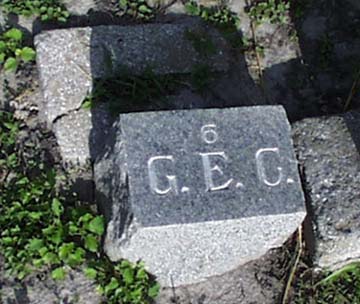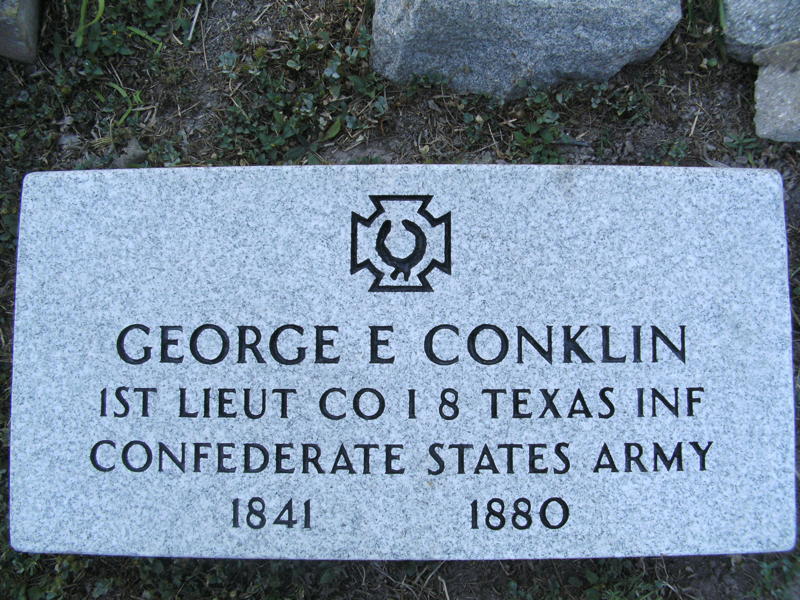George E. Conklin
Confederate veteran
Interment source:
Marie Blucher, Librarian, La Retama Public Library, ca. 1940
As cited in:
Marrow, Mary, Bay View Cemetery. Corpus Christi: La Retama Public Library, 1962.

Photo Credit: Rosa G. Gonzales

Photo Credit: Rosa G. Gonzales
Source: Corpus Christi Weekly Gazette, January 3, 1874, p. 3, col. 3
Research by: Msgr. Michael A. Howell
2. Biography
According to the Marriage Records of Nueces County (Vol. C page 352) on January 9, 1868 Hannah D. Moore, the daughter of John M. Moore and Harriet E. Conklin, married George E. Conklin who was a relative of her mother Harriet. In one account Harriet’s brother and an early partner of John M. Moore in Alabama is also listed as a “George Conklin�. However , the husband of Hannah is certainly not the brother of Harriet as she was born about 1815 in New York, and George (the husband of Hannah Moore) was born in Alabama about 1841 according to his listing in the 1870 census. It seems quite possibly that he may indeed have been a cousin of his wife Hannah. George had been an active citizens in Nueces County since prior to the Civil War according to documents. When citizens of the county met in the Court House for the purpose of ratifying the proceedings of the State Convention that moved to secede from the Union and join the Confederacy, George E. Conklin was present and was elected one of the secretaries of the meeting (Ranchero of 27 April 1861, page 2 col. 3). The Ranchero of 3 May 1861 (page2 col. 3) further notes the service of “George E. Conklin� as secretary when resolutions were approved that included the election of a Committee of Safety. George’s future father-in-law, John M. Moore, was among those elected to that committee. During the Civil War that followed, George was active in military service in Texas. He had been named as a first lieutenant in the muster roll of a Militia of Light Infantry under the command of Capt. W. S. Shaw that was a reserve company authorized for the local county as early as February 14, 1860. On October 24, 1861 in Corpus Christi George took his solemn oath to discharge the duties assigned him as “second Lieutenant of an Artillery Company, enrolled in the provisional Army of the Confederate States, for Coast defense�. Documents from the National Archives report George E. Conklin listed as a 2nd Lieutenant in Capt. Benjamin F. Neal’s Company of Artillery, Texas Volunteers, as early as July of 1862. This company was responsible for protecting the coast from possible Federal troop invasion by water. However, the early reports note that he was often on detached service as Post Adjutant at Lavaca. This “detached service� appears to have been for the purpose of commanding other forces as he is listed in Lavaca as the acting Adjutant for that company under command of Major D. D. Shea. Similarly, documents also show him as a 2nd Lieutenant of Co. B of the Heavy Artillery that is a part of the regiment under the authority of Col. Hobby in December of 1862. By May and June of 1863 he is actually listed as a 1st Lieutenant and the one commanding the company of Neal’s Artillery that is assigned to Capt. Wm. H. Maltby and attached to the 8 Regiment of Texas Infantry (Hobby’s). At that point he is commanding the company that is occupying Mustang Island. His signature appears on numerous vouchers and requisitions. However, again he must have been pulled on some occasions for other service. Correspondence from Col. Hobby to a superior in Houston even indicates that at one point a move was made to transfer Lieutenant Conklin to the Confederate Navy, but Conklin declined to accept upon the condition of going in as a Seaman (letter of Hobby of July 20, 1863). In April of 1864 Hobby wrote Brig. Gen. J. E. Slaughter in Houston to request the presence of Conklin to serve as a witness in a court martial convened at Galveston. At that time Hobby did not know where Conklin was serving. He only knew that Conklin had belonged to Capt. Maltby’s Co. of his (Hobby’s) Regiment. The company had all been captured, with the exception of Conklin, at Aransas Pass. Conklin had apparently been away on detached service and was still believed to be serving on some ordinance duty. The last correspondence appearing in his military files is a letter from George E. Conklin to the chief of Artillery in Houston on February 10th of 1865. In obedience to a Special Order No. 102 from the Artillery Headquarters, now Captain George E. Conklin had been discharging duties in charge of a siege train, moving guns and ammunition for storage and protection near the Sabine River at Sabine Town under the charge of Lt. Col. Thomas B. French. The task ended up involving multiple moves of the supplies and ferrying across the river. Because of ill health he was not able to make the full journey with the supplies which did arrive safely to their destiny. Meanwhile Captain Conklin had returned to Houston. After the Civil War George E. Conklin is mentioned among a group of citizen leaders who organized the Corpus Christi Steamship & Overland Transportation Company, for the purpose of establishing a connection by steam between Corpus Christi and another seaport with a view to also promoting a railroad line. In this project George is listed as “of Roma� so he may have been living in the Rio Grande Valley at that time. This project met competition from the Corpus Christi Coal & Petroleum Railroad Company whose chartered members included George’s future father-in-law John M. Moore (see “Gringo Builders� by J. L. Allhands, pages 68-69). Certainly by 1868 and his marriage to Miss Hanna Moore, George was already involved back in Corpus Christi. However, neither George nor Hannah is found near the Moore family in the 1870 census of Nueces County. It seems the couple may have struck out on their own as they appear to be in New Jersey in the 1870 census. It may be that George was an agent of some sort as he is listed as a clerk. He and Hannah are lodgers with a number of others in what appears to be a boarding house in Newark, Essex County, New Jersey. In this census George says he is 28 years old and a native of Alabama. Hannah reports that she is 26 years old and also a native of Alabama. By 1874 the couple had returned to Corpus Christi it appears as a “George E. Conklin� is listed in the Corpus Christi Weekly Gazette as “Licensed Auctioneer and Notary Public� with his offices in the George French Store (see example from 3 January 1874, page 3 col. 3). Later in May of that year the paper announced that he had a new office on Chaparral Street where he would also officiate as Port Warden as well as perform his previous services (Nueces Valley of 2 May 1874, page 3, col. 3). George apparently continued to exercise these duties over the next years, but by October of 1876 he had moved his office to the store of Noessel & Son at what was popularly called the “Bowery Corner� (Sunday Gazette of 1 October 1876, page 3 col. 4). Possibly out of an effort to support the work of his wife Hannah who lists herself in census records as specifically a music teacher, George also was in partnership with W. S. Halsey as an agent for Werlein’s of New Orleans in order to offer pianos and organs as well as music and other musical merchandise to the community of Corpus Christi. Along with Halsey he continues to list himself also as an agent for “Western Texas and Mexico� as an auctioneer and commission merchant (Sunday Gazette of 1 October 1876, page 2 col. 6). George apparently continued to work the Port also because the Daily Gazette of 15 December 1876 (page 3 col. 1) relates a fight among the draymen on the wharf that resulted in “Recorder Conklin� fining the accused miscreant $10 and costs. The last time George E. Conklin’s advertisement appears in the local papers is in the edition of 20 December 1876 (page 1 col. 5). Unfortunately there are no surviving papers from the following months to indicate when George E. Conklin actually died. He is not listed with Hannah in the 1880 census (Nueces County, page 17B). In this census, Hannah lists herself as 38 years old (and now as a native of New York) who is “widowed�. She is living with her parents and other relatives in Corpus Christi and works as a “music teacher�. Hannah would never marry again though she was relatively young and without children. She did help raise other nephews and nieces and lived to 1913. She was then laid to rest beside George in Old Bayview Cemetery.
Research by: Msgr. Michael A. Howell